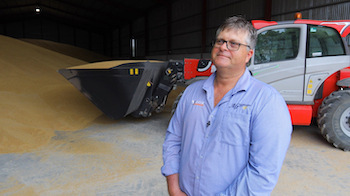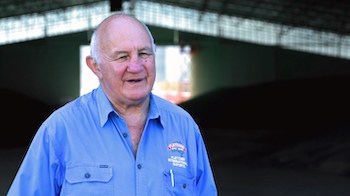Top Australian supply chain experts are examining Australia’s container grain trade to identify ways to improve its opportunities.
A joint investigation by the Australian Export Grains Innovation Centre (AEGIC), GRDC and the South Australian Grains Industry Trust (SAGIT) is consulting with companies active in the container trade to identify supply chain issues and potential solutions.
The project leveraged AEGIC’s experience in analysing export supply chains in Australian and export grain competitor nations, with supply chain experts on the east coast and South Australia involved to ensure regional differences were understood.
The investigation will help companies and growers involved in containerised grain exports by revealing potential changes by industry and government which could improve the efficiency of Australia’s grain supply chains.
Containers: a growing business
Over the past two decades, the value of Australian containerised grains, pulses and fodder has grown. In 2020-21, Australia exported almost 4.2 million tonnes of grain and fodder in containers. Australia is a net importer of containerised goods and, under ordinary circumstances, empty containers are readily available to be filled with grains, pulses, seeds or fodder for export to overseas customers.
Australia’s container operations are concentrated in the ports of Botany, Melbourne, Brisbane, Fremantle and Adelaide. These ports handle more than 5 million containers each year, and many companies in Australia are engaged in the containerised export of grain.
Issues and solutions
AEGIC, together with leading supply chain experts, has spoken to companies and growers involved in the container trade to mine their expertise and gather a broad set of opinions on current and future challenges, and suggested solutions. Data describing the nature and changes in containerised grain trade have also been collected and analysed. The team also formally surveyed dozens of Australian containerised grain exporters. Key opportunities have been identified in four areas:
- Greater export market access for containerised grain and fodder
- More investment in supply chain infrastructure
Investments to create or maintain least-cost, low-emission grain paths for containerised grain and fodder are essential for the future of Australia’s grains industry. Increasing mass limits on grain pathways is required. Fixing inefficiencies in the supply chain caused by larger ships, inadequate rail access to some container ports, and a shortage of space in some empty container parks is also needed. Investment in protection and maintenance of buffer zones of container transport corridors is essential.
- Better oversight and regulation
There is a need to more-effectively monitor bulk and container supply chains to support evidence-based policy-making and beneficial investment. Container port operations need government and industry action to boost their efficiency and avoid spatial monopolist behaviour.
Container port developments by governments and industry must be structured to achieve enduring economic and ESG (environmental, social, governance) outcomes rather than sole short-term budgetary relief or commercial advantage to incumbents.
- More grower education
Many execution risks are associated with the trade of containerised grain and fodder. Growers and other supply chain investors need further education about how to soundly manage commercial risks when exporting containerised grain and fodder.
In their own words: video case study series
As part of evidence-gathering, the project team produced three case study videos, each highlighting a prominent business involved in containerised grain exports.
The highly experienced case study participants included Mark Schilling (AG Schilling & Co, SA), Roger Fletcher (Fletcher International Exports, New South Wales) and Sam Conway (Boolah Farms, NSW).
Mark, Roger and Sam each offered unique and valuable expertise when reflecting on lessons learned from their years of experience in containerising grain. The case studies highlighted some key features of successful container businesses:
Good documentation: providing timely and accurate documentation is essential but can be more time-consuming and difficult than operators anticipate. Commercial operations often benefit from hiring or outsourcing to people with the required skill and knowledge to handle this side of the business.
Specialised knowledge: marketing grain and fodder via containerisation often means learning a new set of specialist skills. At times it makes sense to bring in expertise to facilitate and de-risk that investment and its associated activity. At other times it might be more sensible to acquire those skills, such as training to become an authorised officer.
Efficient use of existing capital: grain containerisation can allow for more-efficient use of existing grain storage facilities, or better use of rail and road transport assets.
Nimbleness: it can be beneficial to be nimble and adaptable in executing sales or stepping out of the market when third-party or execution risks become too large and/or margins too small. On-farm container-packing operations can often be best achieved by using a low capital footprint to lessen risk when market downturn or disruption occurs.
Case study: AG Schilling & Co (South Australia)
Mark Schilling, AG Schilling and Co
 Mark Schilling, AG Schilling and Co
Mark Schilling, AG Schilling and Co
“We have to be a very low-cost operation. So we’ve got to be able to shut down and start up whenever we can. So when I look at the infrastructure cost here, my storage facility, we’re 30,000 tonnes now. Do I use it all? No. Do I use it for machinery? Yes. Do I store other things in there? Yes – hay. So we’re a multi-complex, and being on a farm I can do those things.
“My advice would be to bring in mature people who know how to run a company, for one. Don’t be afraid to pay good money for good people who are on the same page. Communicate on a daily basis. And do a plan, and a budget.
“We’ve got to educate … how to do storage better. It’s been a really big learning curve for me over the past 15 years on how to store grain efficiently and effectively. We probably don’t share knowledge as well as we should. The more people I can help educate in doing on-farm storage, the better off our industry will be, because our consumer is looking for traceable provenance goods. Why not capitalise on that? We grow the best malt barley in the world here in SA, in my opinion. I’ll talk to somebody in Victoria, and they’ll say they grow the best lentils in the world. Why don’t we capitalise on that? It’s about marketing.”
Case study: Boolah Farms (NSW)
Sam Conway, chief operating officer, Boolah Farms
 Sam Conway, Boolah Farms
Sam Conway, Boolah Farms
“We got into container packing as an add-on to our storage and handling business that we were already running. We had the people, equipment and infrastructure that we needed to handle bulk grain, and it was a small investment we had to make to get into container packing.
“By having our own facility here… it gave us an opportunity to go out to the customer, and find these markets, and give them what they wanted and allow us to value-add our product.
“It was very crucial for us: we got a couple of great people involved with experience in the industry – we would have been completely lost without them – and they’re still involved in the business now.
“We found it was important to be able to pack containers really efficiently when those orders were on, to be able to supply what the customer needed. Also be capital-light enough that we could shut it down when we either didn’t have the market, or the product, to pack the containers.
“I think the documentation side of packing containers was a lot more difficult, labour-intensive and crucial, legally, than we initially realised. We outsource what we can to people who are in the game and know what they’re doing.”
Case study: Fletcher International NSW
Roger Fletcher, Fletcher International
 Roger Fletcher, Fletcher International
Roger Fletcher, Fletcher International
“More people (in Asia) are coming into middle class; they want more food, and you know there’s a great challenge there and containers are one way to go, because they can buy them in smaller parcels. The growth is not there for huge bulk-handling systems, and definitely containers have got a part to play.
“You’ve got to look at the challenge – that you can compete with other people. If you can’t, if you’re not in a position to be better than the neighbour down the road, you can’t survive. It’s a very challenging game, there’s a lot of money rolls around, and there’s a lot of things that we’ve got to be prepared for that are out of our control.
“We’ve worked hard on our quarantine situations, and we are one of the lucky countries that is girt by sea, and we can manage that. And I think it’s still a challenge that we can keep managing, and sometimes it irritates us, but it’s a great asset we’ve got and we don’t want to lose that asset.”
The insights gathered as part of this investigation will inform a detailed industry report to be released in mid-late 2022. SAGIT will also release an information pack about the practical steps and risks involved in containerised grain and fodder exports.
The potential changes by industry and government identified in this project will help secure the future for Australian containerised grain exports.
More information: Australia’s containerised grain supply chains - Case study videos.

























































